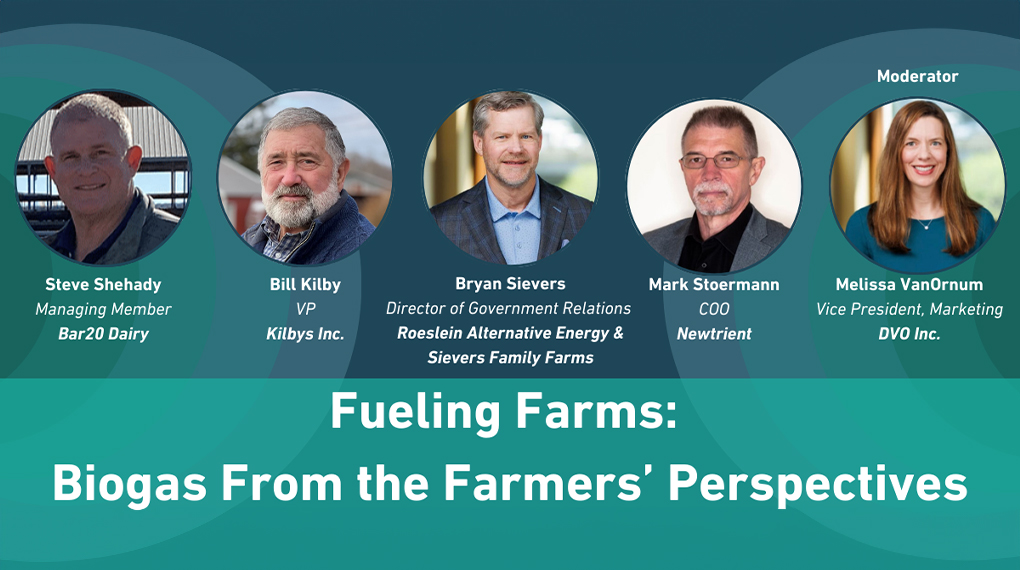With Biogas Americas 2024 just around the corner, DVO’s VP of Marketing and American Biogas Council board member Melissa VanOrnum discusses the importance of bringing the biogas industry together and what she hopes to highlight in the panel discussion she’s moderating at the event.
What about Biogas Americas 2024 are you most looking forward to?
It’s always inspiring to have an opportunity to get together with folks in the industry – so I’d have to say I’m most looking forward to meeting my peers, reconnecting with old contacts, and getting a chance to hear about the different challenges and opportunities those of us in the biogas space are facing.
I’m also really excited about the opportunity to moderate what should be a very interesting and thought-provoking panel featuring perspectives on biogas from farmers – something that, as a Wisconsin native dedicated to bringing the benefits of on-farm biogas to more operations, is near and dear to my heart.
Why is the topic of on-farm biogas and digesters important?
Because on-farm biogas represents a huge and exciting opportunity for farmers, developers, local communities – really anyone who cares about trying to reduce the environmental impact of livestock farming. It’s what’s been driving me and my colleagues at DVO for more than two decades: providing a superior technology that helps farmers increase their efficiency while at the same time cutting their emissions.
For farmers, investing in technology to capture and process biogas can boost income by adding a new revenue stream, while at the same time lowering what they spend on inputs and fuel.
On-farm biogas can also provide developers and investors with attractive renewable energy investment opportunities with clear emissions reduction benefits.
But if there’s one thing we’ve learned over more than 20 years and 200 projects, it’s that realizing the opportunity of on-farm biogas is often more complicated than many people realize.
Developers and farmers come from different worlds and it’s not always easy for one side to fully understand where the other one is coming from. And that’s something I hope we can explore in our panel discussion at Biogas Americas 2024.
What can you tell us about the perspectives represented on the panel?
The folks at the American Biogas Council have done a great job pulling together a diverse and knowledgeable panel representing a range of perspectives. There’s Steve Shehady from Bar20 Dairy in California, which has been referred to as California’s “most sustainable dairy,” and Bill Kilby, who was an early adopter and advocate of digester technology on his farm in rural Maryland.
Then there’s Bryan Sievers, a family farmer from Iowa who served in the state legislature and works for an alternative energy company. As an owner and operator of an on-farm digester, he understands how they can benefit farmers. I’m also thrilled to have Mark Stoermann from Newtrient, who really is an evangelist for the industry and has extensive experience overseeing anaerobic digester projects on dairy farms.
I expect the panelists will share their thoughts about what’s needed to make an on-farm biogas project successful, from permitting to community relations to contract structures. There’s going to be a lot of knowledge on that stage.
What are some of the most common misconceptions between farmers and biogas developers?
At a high level, it’s almost a Mars-Venus situation. Each side comes from a different place, speaks a different language, and may have different things jump out at them when standing in front of the same barn or staring at the same spreadsheet.
As I mentioned, biogas investors and developers often don’t have a lot of first-hand experience with the day-to-day realities of running a farm. Similarly, farmers may not have spent much time digging into the complexities of energy markets and project financing.
If both sides of the biogas equation fail to really understand one another and how they can each benefit from entering a true partnership, promising opportunities may be overlooked or get derailed by unrealistic expectations.
That’s why I think this panel is so important to include in the Biogas Americas 2024 agenda. It’s an opportunity to bridge that Mars-Venus gap and make sure farmers and developers can find alignment about what to expect when starting an on-farm biogas project.
What do you hope Biogas Americas 2024 attendees will get out of coming to your panel?
I hope they come away with a deeper appreciation of the many benefits that on-farm biogas can bring to both investors and farmers, and that both sides feel like they understand at least a little better where the other is coming from. On a practical level, maybe it’s as simple as knowing what questions to ask and how to ask them so that everyone feels confident about the chances for success.
I also hope people understand how complicated these projects are compared to other renewable energy projects or other on-farm investments. There are a lot of moving parts and potential complications that both sides need to be aware of and address in a way that works for everyone.
Hopefully, a better understanding will lead to more and more successful projects, which will help strengthen both farmers’ operations and the biogas industry as a whole.
